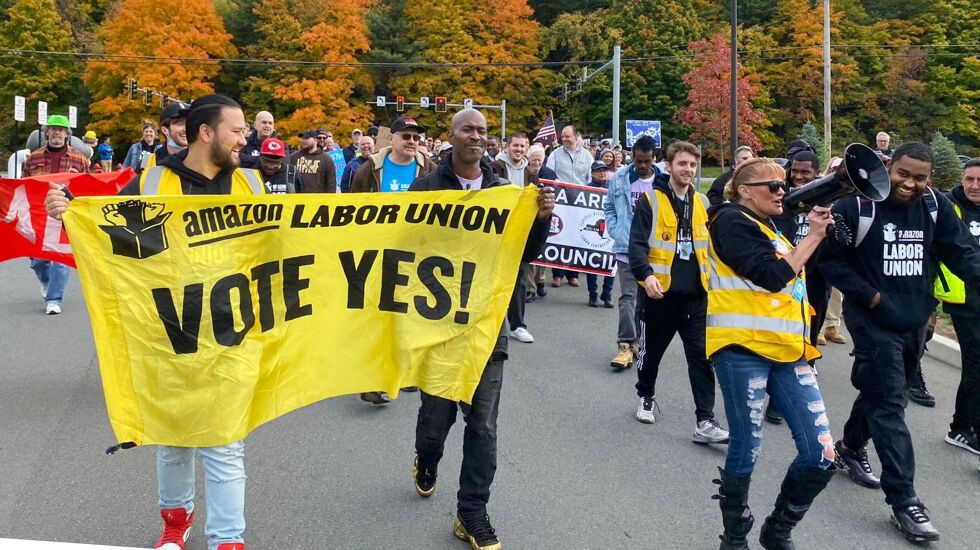
NEW YORK — Amazon workers in upstate New York overwhelmingly rejected a union bid on Tuesday, handing a second defeat to the labor group that’s been attempting to drag the company to the negotiating table since its historic win earlier this year.
This time around, warehouse workers near Albany cast 406 votes — or about 66% — against the Amazon Labor Union, giving the company enough support to push back the fledgling group composed of former and current Amazon workers.
According to the National Labor Relations Board, which is responsible for overseeing the election, 206 workers — or 33.6% — voted in favor of joining the union. The agency said 949 employees were eligible to vote, and the 31 ballots that were challenged by either Amazon or the union were not enough to sway the outcome.
The facility is in the town of Schodack, near one of the most unionized metro areas in the country, according to Unionstats.com. It’s what’s known as a non-sort center, a warehouse where employees pack more bulky items such as rugs, patio furniture or outdoor equipment.
Experts had noted a win there would have given the union more leverage in its quest to negotiate a contract with Amazon and a chance to demonstrate its prior win at a facility on Staten Island, New York, wasn’t a one-off. For now, those hopes seem to be dashed.
“We’re glad that our team in Albany was able to have their voices heard, and that they chose to keep the direct relationship with Amazon as we think that this is the best arrangement for both our employees and customers,” Amazon spokesperson Kelly Nantel said in a statement. “We will continue to work directly with our teammates in Albany, as we do everywhere, to keep making Amazon better every day.”
Chris Smalls, the fired Amazon worker who led the ALU to a first-ever victory of an Amazon warehouse in the U.S., said in a statement that his group was proud of the workers who challenged Amazon’s “vicious anti-union campaign” and signaled they might try to unionize the facility again.
“This won’t be the end of ALU at ALB1,” Smalls said, using the official name for the warehouse. He noted organizers were feeling “both anger and disappointment,” saying “the voting process wasn’t free and fair” and accusing the company of “putting their thumb on the scale.”
“It was a sham election where workers were subjected to intimidation and retaliation on a daily basis and even the workers who volunteered to be election observers were faced with threats of termination,” Smalls said.
In the past week, organizers have said Amazon threatened to take away unpaid time off from workers who volunteered to be election observers. Heather Goodall, the main organizer at the facility, has accused the company of calling police on her several times while she was soliciting support near the facility during her time off. An Amazon spokesperson said the company only did that when non-employees were present.
During the campaign, the union filed more than two dozen charges with the NLRB accusing the company of unfair labor practices that damaged its ability to organize. Still, Smalls noted they were going to continue their campaign to unionize Amazon warehouses.
“You miss 100 percent of the shots you don’t take,” he said.
This was the fourth union election at an Amazon warehouse this year, and the third one led by the ALU. Following their unexpected win in April in Staten Island, the group was stung by a loss shortly thereafter at another, smaller facility nearby. A union election in Alabama, led by the Retail, Wholesale and Department Store Union at a warehouse in Bessemer, Alabama, remains too close to call.
Goodall launched the organizing drive near Albany in the spring, just a few months after she joined the company to assess working conditions. Soon after that, she approached the ALU after gaining some support from workers who wanted to unionize.
To push back, Amazon had been holding mandatory meetings for its employees urging them to reject the union, the kind of meetings the NLRB’s top prosecutor is now attempting to outlaw. The company has also been hanging fliers and other literature around the facility encouraging workers to vote no.
The election outside Albany marked the first time the union was tested beyond Staten Island. Before the group’s first loss, many believed organizing the second Staten Island facility would be more challenging due to the larger share of part-time workers, who might have other sources of income and less of a connection with their co-workers. The union had less time to convince workers. Smalls and other organizers were also more distracted with media appearances and defending their historic win.
Amazon has been trying to undo the ALU’s lone victory, filing more than two dozen objections to the election and seeking a redo vote. Last month, a federal labor official concluded the union should be certified as a bargaining representative for the warehouse. Amazon, which hasn’t recognized the union, said it intends to appeal the decision and CEO Andy Jassy has also signaled the company could take the case to federal court.
ALU organizers have said they were focused on pressuring Amazon to negotiate a contract at the facility that voted to unionize and petitioning for more elections. Last week, Amazon workers at a separate facility in California filed for their own union election, seeking to join the ALU.







